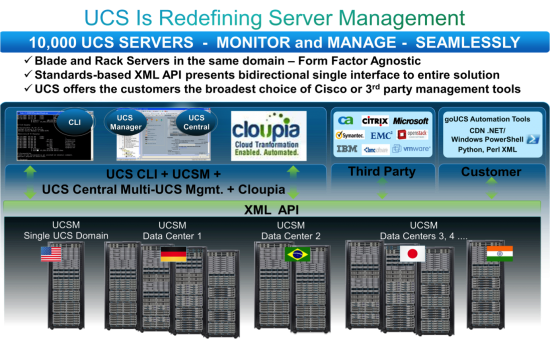































Fabric-Based Infrastructure and Cisco UCS
A good segue to Fabric-Based Infrastructure is Gartner'sMagic Quadrant for Blade Servers(March 2012), by Andrew Butler and George Weiss. To fully understand the tie in with Fabric-Based Infrastructure I suggest reading the section on Cisco UCS. Their observations are important because they tie directly to the subject of this blog. You will also get a better feel for why Cisco UCS is having such rapid customer adoption worldwide.
The emphasis for Fabric-Based Infrastructure is delivering value-add functionality that enables data centers to operate more efficiently and cost effectively. A good place to start is by looking at this Gartner report by George Weiss and Donna Scott -Fabric-Based Infrastructure Enablers and Inhibitors Through the Lens of User Experiences(April 2012). In this short research note, George and Donna go into the key drivers and reasons for the FBI architecture and the benefits that their clients have seen. My take away for the key benefits of Fabric-Based Infrastructure are:
While reading about a technology innovation is helpful, actually listening to experts discuss the architecture and give their individual perspectives can be more so.
I suggest that you make time to listen to this 34 minute video with featured guest Donna Scott (a VP and Distinguished Analyst at Gartner) and Paul Perez (VP and CTO for the Data Center Business Group at Cisco Systems) -Fabric-Based Infrastructure (FBI) in Today's Data Center. Donna looks at the motivations and impact of customers moving to a Fabric Based Infrastructure with an eye toward what is important to adopters. Then Paul discusses Cisco UCS innovations and how they let FBI adopters achieve their goals. If you would like, you can download a podcast of the video from theCisco Analyst Reports page.
From my perspective the truly compelling part of this story is the extent to whichCisco UCSmakes the promise of Fabric-Based Infrastructure a reality, while emphasizing safety, security and the risk reduction. These are critical considerations in today's IT environment. Cisco continues to be a key innovator in data center technology and is continuing to grow from strength to strength, delivering value and benefit for your long termapplication solutionneeds.
Below is how I think a Fabric-Based Infrastructure should look. Of course I am predisposed. Cisco UCS architectureprovides the ability to define and manage over120 different server identity parameters via service profile templates, using a native tool with Roles Based Access Controls and across geographies. UCS enables you to have a distributed environment that is centrally managed. Your admins can also use CLI, custom designed tools / scripts, or third party tools as they choose to meet the needs of their current management structure. 
Fabric-Based Infrastructure (FBI for short) for me is really about how IT departments can abstract server identities from the physical hardware, making it easy to duplicate and automate server identities at scale, minimizing errors, work and complexity and do it FAST. Fast is important because downtime and long Recovery Time Objectives (RTO) can severely impact business performance and profitability. FAST requires service profiles and templates that let you leverage existing server configurations and connect to the LAN and SAN environments as an integrated, natural part of the task. The key is to:
Your data center administrators must be able to consistently apply server identity parameters, networking, QoS, security, and compliance on a holistic basis, regardless of location for any physical server or whether the target is a blade or a rack optimized server. This is beyond what can be done with hypervisors and should include I/O management features.
To fully utilize Fabric-Based Infrastructure design, you must also be able to manage your I/O within a unified infrastructure. Cisco VM-FEXcollapses virtual and physical networking into a single management architecture that lets you: provision, configure, manage, monitor, and diagnose virtual machine network traffic and bare metal network traffic in a single unified infrastructure. Using Cisco VM-FEX technology can eliminate the need for a virtual hypervisor switch completely, freeing up processor cycles by eliminating virtual switch overhead.
The full list of Fabric-Based Infrastructure enablers are high value-add benefits on which Cisco UCS delivers. If you have to do this by adding multiple tools, consoles, and databases, which must be hosted, managed, updated and maintained separately, you just increase cost and complexity, while increasing risk.
Want to read more about Fabric-Based Infrastructure and Fabric Computing? You can find a number of relevant papers by various analyst here -Analyst Reports on Cisco.com.
 Etiquetas calientes:
Centro de datos
Red red
Cisco UCS
UCS
intelligent automation
Server Management
Fabric computing
Fabric-Based Infrastructure
data center management
Etiquetas calientes:
Centro de datos
Red red
Cisco UCS
UCS
intelligent automation
Server Management
Fabric computing
Fabric-Based Infrastructure
data center management